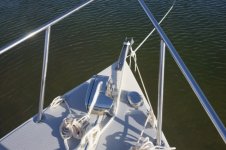A lot depends on your anchor, anchoring skills and the type of bottom. If you are hooked into good sand, with a Fortress or Danforth HT anchor, then you are safe.
Normally when I anchor I take a turn around and thru where I am going to anchor. I have the depth sounder on, and look at whee other boats anchors are lying. The new "down scan" transducers give a very nice picture of the bottom and can help.
I lower the anchor (Never throw it) and when it hits bottom, I then start going astern. After I have scope out (includes the depth of the water and the height of the bow off the water. (On some of my larger boats, I had a block near the water line, I could pass the anchor line thru.). At 3:1 scope, I will start to put a little tension on the anchor rode and "test it"--seeing if the boat weight, with no engine power will hold the boat in place. Then I let the anchor rode free wheel, and at about this 6:1 scope. I begin to apply increasing reverse power. When the anchor seems to be holding, I give full reverse to completely set the anchor. I may also set a stern anchor--that is also set with 7:1 scope. There are some places where one anchor off the bow is correct, some where two, 180 degrees apart (Reversing tidal current), and some where you want 3 bow anchors (heavy winds where the wind will probably change direction.
I like to either dive on the anchor or try and visualize the anchor on the bottom. The first boat to anchor or permanent moorings set the stage for type of anchoring (one two or three anchors.). If a boat is anchored on a single anchor, then other boats anchoring nearby should ride to a single anchor, nearby boats should also be on a single anchor.
I use lighter snubbing or shock adsorbing lines to take the load and any chafe off the main rode. I either use chafing gear, or have a fair lead where there is no possibility of chafe.
I prefer to anchor so that at low tide I still have over 2 X the draft of the boat, under the boat. I have anchored the C Dory at Powell with only a couple of inches under the stern. Two stern anchors, and enough scope out that I am still 6 to 7 to one when I pull off the beach.
The strongest winds I have anchored in were 90 knots. I have changed anchorages as often as 3 times a night, and I have had to "cut and run" once--where two bow anchors were dragging due to the type of bottom (what I call "ball bearing" small stones. There is no anchor which will really hold in that type of bottom.
Setting an alarm on a depth sounder is prudent, as is a circle alarm on the GPS. I will take sights by compass bearing and by radar to check to see if I am dragging or not. I carry at least 3 anchors, even on the C Dory 22. The Fortress or Guardian anchors disassemble into an easily stored bundle.
In suspicious areas, or in case of a storm I have an anchor watch. If the wind shifts to put my boat at risk toward the shore or shoal water, with danger of increased seas, then I move the boat to a more protected space.
Once on an oxbow off the St. Johns a friend was anchored to windward of me, and started to drag. I hit the horn to awaken my friend. As he drug past, I decided it was the better plan to up my anchor and anchor in another part of the oxbow. I have had boats drag and snag my anchor chain--in some cases that has tripped my anchor--and that needs to be sorted out immediately. If a smaller lighter boat does that, and you are not dragging, then wait until you are ready to before pulling your rode and then let them know. I once had six 26' charter sailboats anchor to windward of my anchor, and during a stormy night all drug, and hooked into my anchor chain. My boat was 62 feet and about 10X the displacement (6,000 lbs, to my 68,000 lbs. I had all chain out, and a large anchor, so there did not seem to be any risk.
At the Isthmus on Catalina Island, on a holiday weekend when I could not get a mooring, I always carried at least two spare anchors, and rodes to loan to boats which didn't have adequate anchors, and would drag into my boat. I would set the spare anchors with my RIB, and then pass them to the boat which had been dragging.
Pulling an anchor--power the boat towards the place where the anchor is set. Use the windlass to take up the anchor rode/chain slack. When over the anchor, secure the windlass gypsy and use the boat to pull the anchor to "break out". After the anchor has broken out, then use the windlass to being the rode and anchor into the full up position.
An anchor marking buoy: In areas where the bottom may be foul--big rocks, cables, debris etc, I often will put a relatively light line from anchor crown to a buoy marked blue and white. this way, I can pull the anchor out by its crown if it is stuck. I have had that either picked up in another boat's prop, or once a smaller boat thought that this buoy was a mooring, attmepted to pick it up. I warned them off.
Anchoring properly is both an art and science.

